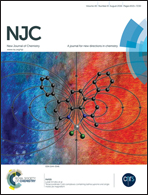Thiol–ene click chemistry for the design of diol porous monoliths with hydrophilic surface interaction ability: a capillary electrochromatography study
Abstract
A monolithic material with dual functionality was successfully synthesized through the combination of UV-initiated free radical copolymerization, nucleophilic substitution reaction and thiol–ene radical photoaddition. Firstly, poly(N-acryloxysuccinimide-co-ethylene dimethacrylate) was prepared by non-solvent induced phase separation occurring within the course of the polymerization of the respective monomers. Toluene was selected as a porogen providing percolating pores in the micrometer range. Secondly, N-hydroxysuccinimide units on the monolith surface were converted into ene functionality through covalent immobilization of allylamine. Finally, thioglycerol served as a hydrophilizing agent of the pore surface via surface confined thiol–ene click grafting. All the preparation steps were performed, in situ, i.e. within the confines of UV-transparent capillary channels, affording a micro-column with electro-osmotic flow generation and hydrogen bond forming abilities. Raman microspectrocopy confirmed that all the synthetic steps were accomplished successfully. Investigation of the electrochromatographic retention behavior of hydrophobic and hydrophilic solutes revealed the possibility of tuning the interfacial character of the diol-functionalized monolithic stationary phases with respect to the water content in the surrounding liquid phase. For the acetonitrile-rich mobile phase, the diol-monolith interface exhibited highly hydrophilic character allowing fast and efficient separation of phenol and aniline derivatives, as well as methylxanthines and pyrimidic bases. Moreover, the relative standard deviation of the retention factor values was less than 3.3%.


 Please wait while we load your content...
Please wait while we load your content...